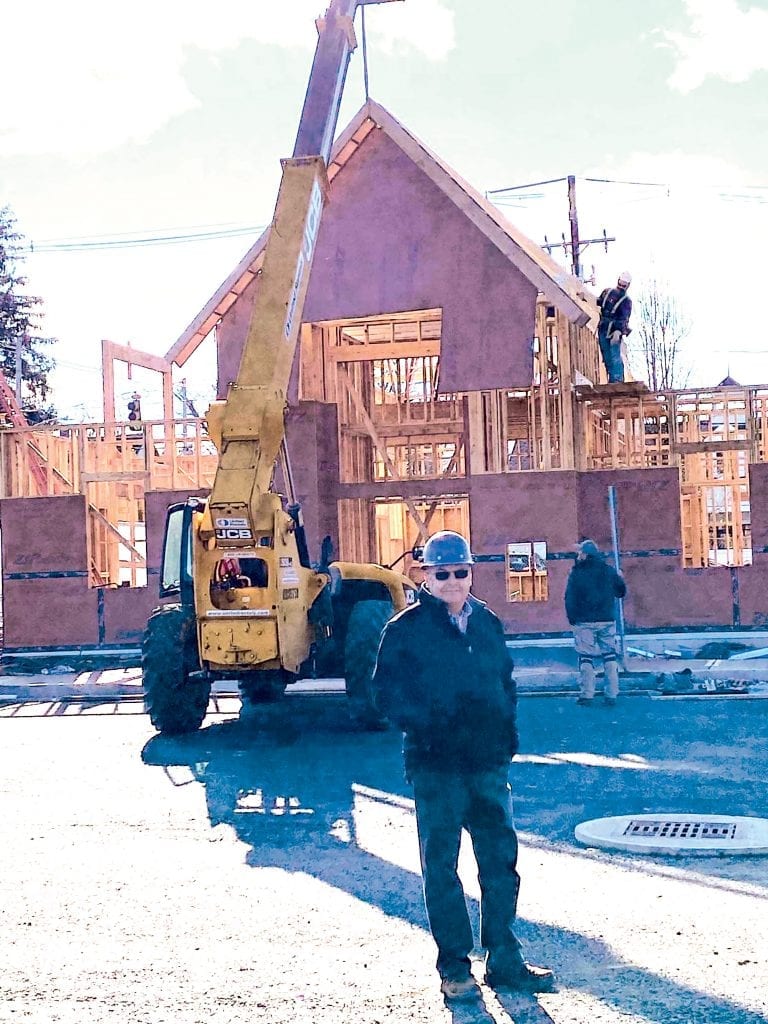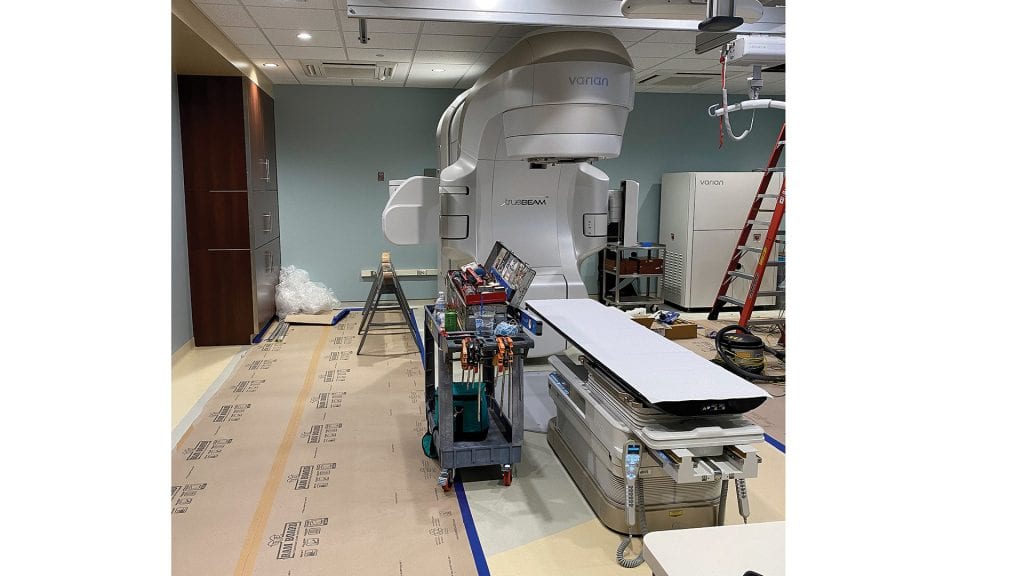Safety First
By Mark Morris

Carl Mercieri says the pandemic protocols have been challenging, but they’ve kept his company’s job sites totally free of COVID-19.
Call it a time of constant adjustments.
Since COVID-19 hit, area contractors have continued to work after adopting a number of state-mandated safety protocols to prevent the spread of coronavirus. Construction managers have adjusted to the extra requirements to get the job done, but it has come with a learning curve.
After working with safety consultants, Kevin Perrier, president of Five Star Group, said his company established a COVID-19 compliance plan and implemented it across all its job sites.
“It’s been helpful because it covers everything — daily sign-in sheets, temperature checks, self-reporting procedures, sanitation of the job site, and social distancing.”
Even with a solid plan, Perrier admits the additional protocols make it more challenging to bring projects to completion on time.
“We try to maintain social distancing as much as possible, and that delays our production. The reason for the slowdown is that we can’t cram as many workers onto the sites as we have in the past.”
Tim Pelletier, president of Raymond R. Houle Construction, said it’s a common occurrence on a job site for a large number of people to work in close proximity to each other.
“There’s a point where you have lots of moving parts, where different trades are working together in order to meet a completion schedule,” he said. “Because of coronavirus mandates, we can no longer have large numbers of people in one spot.”
In the beginning, adopting the safety mandates proved cumbersome as Pelletier would allow only one trade at a time to work on a site. After a few adjustments, more crews were able to be on site and still follow the guidelines.
“It’s a challenge to stay on schedule, but at least we’re now able to bring more than one trade in at a time and assign them work in different areas, so they’re not on top of each other,” he noted.
Wearing a mask all day has also been met with grudging acceptance; Pelletier said crews typically look forward to the moment they can remove them. “In the 90-degree weather, wearing a mask is definitely a health concern, as well as a comfort concern, but they are required, so we wear them.”
In the early days of the pandemic, shortages of personal protective equipment (PPE) also affected construction projects, as each site needed certain quantities for workers, as well as extra devices such as thermometers and wash stations.
At the beginning of the pandemic, Marois Construction was overpaying for — and overbuying — things like thermometers because they didn’t know how many they would need, said Carl Mercieri, vice president and project manager. On one occasion, he recalled, the project owner stepped in and provided enough hand-washing stations for the entire construction site.
“That worked out well,” he said. “Everyone did what they had to do, and we got through it together.”
Pandemic Problems
Implementing safety protocols didn’t always go smoothly early in the pandemic. Mercieri noted a school building project where as many as 30 workers stood in line each morning for a temperature screening and sign-in before they could start their workday.
“Our biggest concern was the loss of labor caused by all the downtime in the beginning,” he said. “It’s hard to put a number on it, and you can never really recoup that cost.”
Building material costs also increased with the onset of the pandemic. Perrier’s construction portfolio includes retail buildings, which require substantial quantities of lumber. So far this year, lumber wholesalers are reporting price increases of 300%, and, to make matters worse, they won’t hold those inflated prices for more than 48 hours.
Kevin Perrier
“We try to maintain social distancing as much as possible, and that delays our production. The reason for the slowdown is that we can’t cram as many workers onto the sites as we have in the past.”
“The volatility of lumber prices makes it difficult to bid on a large, wood-framed project that we wouldn’t be framing until next summer,” he said. “It’s a big problem because you really have no idea where the pricing is going to be.”
Availability of building materials has also been an issue this year. Perrier said light fixtures and flooring materials are two items he’s had trouble procuring for the last several months, while Pelletier said doors and hardware have been in short supply. Rahkonen said finding certain parts for heavy equipment, such as excavators, has been difficult as well.
“We had a couple projects that needed vinyl fencing, and we just couldn’t get it because it just wasn’t out there,” Mercieri said. “We’ve since finished those jobs, but we were delayed by four to six weeks in getting the fencing.”
Much of the supply deficits are caused by overseas factories that experienced shutdowns early in the pandemic. These manufacturing delays from months ago are still being felt now as contractors need these supplies. “We just can’t meet the same deadlines because we can’t get our hands on the materials,” Pelletier said.
From the delays caused by socially distanced workers to not having materials when they’re needed, Pelletier said it’s difficult to take on fast-track jobs that need to hit a deadline. Mercieri echoed that point when discussing his company’s many jobs at hospitals.
“If you are renovating an operating room, for example, the hospital will need it back on line by a certain date, no matter what.”
Mercieri also mentioned a recent instance where he was offered a project that involved complicated construction and needed to be built on a tight schedule.
“When COVID hit, we were up front with the owners and advised them that, with the tight schedule and all the uncertainties of COVID causing delays, they might want to consider some alternate plans,” he told BusinessWest. “They rejected our suggestion and wanted to move forward at 100%, but ultimately they scrapped the project.”
Another concern early on was lost time due to COVID-19 infections. However, Mercieri said none of his workers have tested positive. The closest call was an exposed plumber who was not on site, but had worked with the plumber on Mercieri’s job site. Contact tracing revealed these two had not worked together in the previous six weeks. Perrier said a few of his employees and subcontractors on projects in Eastern Mass. weren’t so lucky and contracted coronavirus.
“We shut down the site for two or three weeks while contact tracing was completed,” he said, adding that the employees recovered, and everyone who had been affected tested negative. “Sites were sanitized, and then back to work.”
Tim Pelletier
“It’s a challenge to stay on schedule, but at least we’re now able to bring more than one trade in at a time and assign them work in different areas, so they’re not on top of each other.”
John Rahkonen, owner of Northern Constructions Service, said four of his employees came down with minor cases of COVID-19, with one showing no symptoms at all. He was quick to point out that no one contracted the virus from the job site.
“Even though most of our crews work outside, we encourage people to stay in their own bubbles,” Rahkonen said. “If you stay within your bubble, you’ll be in pretty good shape.”
Widespread Impact
The economic impact of COVID-19 on a national level is often reflected at the local level, especially for construction companies. In the travel sector, Standard and Poor’s recently projected a 70% decline in airline-passenger traffic for 2020. The core business of Perrier’s company involves aviation construction, ranging from airline and rental-car facilities to restaurants and retail stores located at Logan International, Bradley International, and other airports.
“We had a considerable amount of work that, within a period of two weeks, was flat-out cancelled for the airlines,” he said. “A great deal of the other work was either temporarily postponed or put on an indefinite hold.” One large airline client told Perrier that its facility’s goal was to reach a “zero spend by November first.”
Two to three months into the pandemic, Mercieri began getting word of projects being canceled. His company had already bought materials to start construction for one of those projects.
“When they first shut us down, they told us it was temporary,” he said. “Then, six weeks later, they wrote us a letter to say they had canceled the project.”
Two natural-gas compression stations that Rahkonen’s company had planned to build in Pennsylvania this year have been put off until next year. While those still look viable for 2021, they represent $20 million less in projects for Northern Construction this year.
Perrier predicts the long-term impact of aviation construction will be felt by many for years to come. That’s why his company has diversified into other industries besides aviation.

Houle Construction continues to take on work in the medical field, including this recent project at a local hospital.
“We are doing a decent amount of work in the cannabis industry. It’s booming right now, so that’s helped us out,” he said. One project nearing completion is Dreamer, a cannabis dispensary in Southampton scheduled to open in 2021.
The holiday season tends to be a time when activity begins to slow down in construction and many jobs approach their completion. It’s also a time for active bidding on projects for next year. Mercieri struck a positive tone and suggested a possible rebound in construction activity for 2021.
“Back in March, a lot of projects were delayed, and now they are getting put back on the table and going out for bid,” he said, adding that some of the projects getting approved involve bringing public buildings into compliance with COVID-19 mandates.
When Pelletier surveys the landscape, he senses both uncertainty and hopefulness.
“Clients have had projects on the docket to get done but were skittish for the last seven months, and with a rise in case count, there is still some uncertainty,” he said. “On the plus side, interest rates are extremely low, so borrowing the money for a project is less expensive now.”
Pelletier and the other managers we spoke with have all taken a one-day-at-a-time approach because they understand that coronavirus levels, and the government regulations aimed at lowering them, will most likely change again — and they will simply make the necessary adjustments.
“Because we’re wearing masks all day, everyone has a sore on their nose and a generally irritated demeanor,” Pelletier said. “But we’re navigating through it.”








